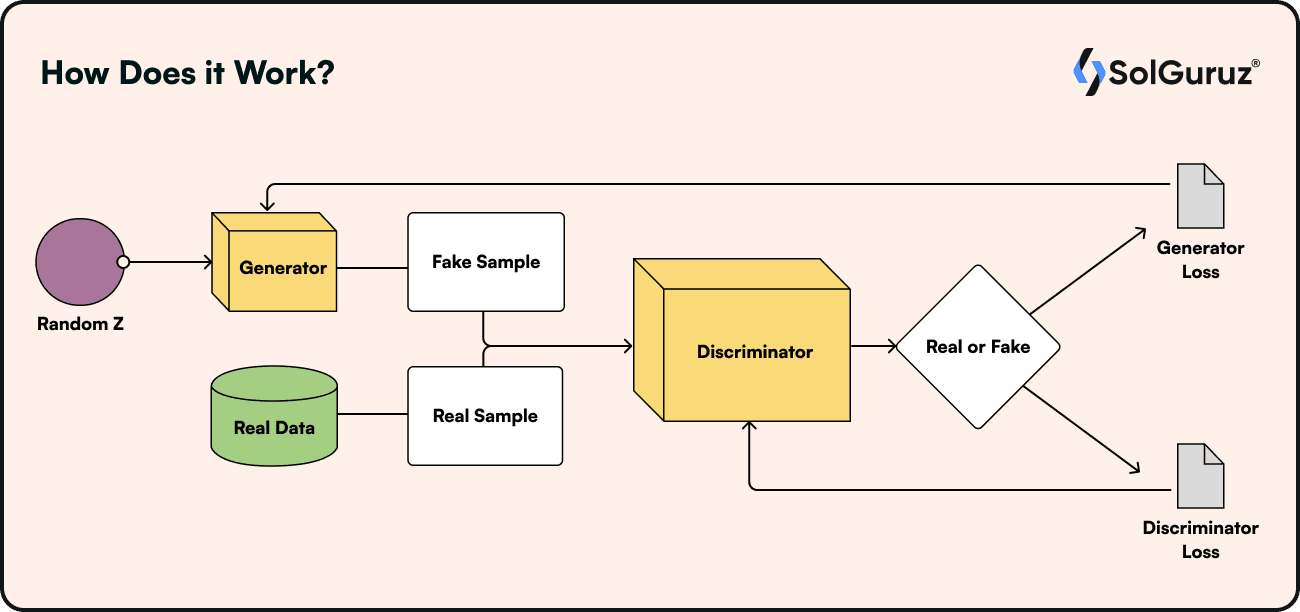What are Generative Adversarial Networks (GANs)?
Generative Adversarial Networks (GANs) use two competing models to generate realistic data. This guide explains how GANs work, their architecture, strengths, limitations, and where they are used in image, video, and data generation.
An architecture for deep learning is called a generative adversarial network (GAN). It creates a competition between two neural networks to see which of the training datasets can produce more genuine new data.
GAN can be typically called a “War of Bots,” where two different neural networks are pitted against each other. Here, the winner remains blissfully unchanged, and the loser has to update.
The “adversarial” part refers to the totally different natures of the two neural networks, the generator and discriminator.
A Little Something About “Unsupervised” vs. “Supervised Learning”
The main distinction between supervised and unsupervised learning strategies is the kind of input data utilized to train the model. In supervised learning, labeled training datasets are used to attempt to teach a model a predetermined, targeted objective.
Unsupervised learning, on the other hand, uses unlabeled data and works independently to attempt to figure out the data's structure without receiving any specific guidance.
Components of GANs
The two main components of GANs are -
Generator
It's an approach to unsupervised learning. Its purpose is to create a fake image based on feedback and fool the discriminator into thinking it cannot detect a fake image. When the generator succeeds in fooling the discriminator, the training process is said to be over and a generalized GAN Techniques model has been created.
Discriminator
The discriminator follows a supervised approach. The discriminator is assigned a simple job of classifying data as real or fake. The discriminator is trained on real data. It also provides feedback to the generator.
How Does it Work?
The working of GAN is basically a game of “show and tell.” An improvised show and tell where the discriminator neural networks are fed with real/original data and trained to identify.
The generator, as the name suggests, is busy generating the data using the input prompts. When the data generated by the generator is labeled fake, the “Generator” neural network updates the information on the basis of feedback provided by the discriminator. It keeps on generating data until it successfully generates the data that the discriminator approves.

Let us understand with an example –
The models are given to see if they recognize a cat or not.
Step 1 –
Generator and Discriminator are two sets of neural networks. The discriminator is fed with a set of real data. In this case, multiple images of a cat. On the other side, the generator generates some pictures of the cat on basic instructions, like a four-legged mammal, an animal looks like a tiger but is small.
Step 2 –
The generator generates some pictures of an animal looking like a cat. But not cat. These pictures are fed to the discriminator. The discriminator is well generalized, learned, and understands what a real cat looks like. It rejects the picture.
Step 3 –
The feedback goes to the Generator. It updates the model. And regenerates some pictures. Again, it was rejected as fake. Again, the generator takes up the feedback and updates itself. After repeated instances and repeated updations, the generator finally generates an actual cat picture. This time the discriminator accepts the image as real.
What Happened Here?
The generator updates the model with the new information each time it gets rejected and works on it. In this process, the generator neural networks are working on feedback, so they constantly improvise. The discriminator is fed with real data but has no updates.
Eventually, constant feedback occurs when the generator creates fake data, but since the data resembles real data, the discriminator model is unable to identify and accept it as real data.
Types of GANs
There are different types of GANs. Here, we have mentioned some types of GANs -
1. Deep Convolutional GAN (DC GAN)
It is among the most popular and effective GAN architecture. Its implementation makes use of ConvNets as opposed to a multi-layered perceptron. The ConvNets are built with convolutional strides and have partially linked layers without max pooling.
2. Conditional and Unconditional GANs (CGAN)
A conditional GAN is a deep-learning neural network with a few conditional parameters. Labels are also supplied to the discriminator's inputs to help classify the data appropriately. This practice keeps the generator from filling them up too quickly.
3. Vanilla GAN
In this instance, the Discriminator and the Generator are straightforward multi-layer perceptrons. The basic algorithm of a vanilla GAN uses stochastic gradient descent to optimize the mathematical problem.
4. Super Resolution GAN (SRGAN)
As the name implies, SRGAN is a GAN design technique that generates higher-resolution images by combining an adversarial network with a deep neural network. This kind of GAN is really helpful for enhancing the details of original low-resolution photos while decreasing errors.
Use Cases of GANs
GANs have very varied applications. Different domains have different GAN applications, giving different results.
Image Generation
Using text-based prompts or altering pre-existing images, generative adversarial networks produce realistic images. Video games and other digital entertainment can aid in producing realistic and captivating visual experiences.
Additionally, GAN is capable of picture editing, such as transforming a black-and-white image to color or a low-resolution image to a high-resolution image. For animation and video, it can also produce lifelike faces, characters, and animals.
Video Editing
GANs are prevalently used in image generation. However, a very effective use is in video editing. GANs are predictive in nature. This can be used to predict the next frame.
Another application is re-editing old videos to improve their quality per frame. A popular YouTuber, Denis Shiryaev, upscales old videos from the 1900s from black and white to color with a better frame rate.
Fill in all the blanks – Fill in Missing Information
There are situations where you might want the generative model to fill in the blanks in a dataset with precise guesses.
For example, by comprehending the association between surface data and subterranean structures, you may train a GAN to produce images of the surface below ground or sub-surface. It can generate new subsurface images using terrain maps for energy applications such as geothermal mapping and carbon capture and storage by analyzing existing ones.
3-D Object Generation
Shape generation with GANs enables the production of shapes that are more like the original. Intricate shapes can also be created and modified to achieve the desired outcome.
Conclusion
Generative Adversarial Networks (GANs) are a powerful paradigm in machine learning with many applications and features. GANs have demonstrated remarkable efficiency in generating realistic data. Enhancing image processing and facilitating inventive applications are some other distinct applications of GANs. Nevertheless, as demonstrated by their useful application on datasets like MNIST, GANs possess enormous potential to transform a variety of fields with the right understanding and execution.
Looking for an AI Development Partner?
SolGuruz helps you build reliable, production-ready AI solutions - from LLM apps and AI agents to end-to-end AI product development.

Strict NDA

Trusted by Startups & Enterprises Worldwide

Flexible Engagement Models

1 Week Risk-Free Trial
Give us a call now!

+1 (724) 577-7737
Next-Gen AI Development Services
As a leading AI development agency, we build intelligent, scalable solutions - from LLM apps to AI agents and automation workflows. Our AI development services help modern businesses upgrade their products, streamline operations, and launch powerful AI-driven experiences faster.
Why SolGuruz Is the #1 AI Development Company?
Most teams can build AI features. We build AI that moves your business forward.
As a trusted AI development agency, we don’t just offer AI software development services. We combine strategy, engineering, and product thinking to deliver solutions that are practical, scalable, and aligned with real business outcomes - not just hype.
Why Global Brands Choose SolGuruz as Their AI Development Company:
Business - First Approach
We always begin by understanding what you're really trying to achieve, like automating any mundane task, improving decision-making processes, or personalizing user experiences. Whatever it is, we will make sure to build an AI solution that strictly meets your business goals and not just any latest technology.
Custom AI Development (No Templates, No Generic Models)
Every business is unique, and so is its workflow, data, and challenges. That's why we don't believe in using templates or ready-made models. Instead, what we do is design your AI solution from scratch, specifically for your needs, so that you get exactly what works for your business.
Fast Delivery With Proven Engineering Processes
We know your time matters. That's why we follow a solid, well-tested delivery process. Our developers move fast and stay flexible to make changes. Moreover, we always keep you posted at every step of the AI software development process.
Senior AI Engineers & Product Experts
When you work with us, you're teaming up with experienced AI engineers, data scientists, and designers who've delivered real results across industries. And they are not just technically strong but actually know how to turn complex ideas into working products that are clean, efficient, and user-friendly.
Transparent, Reliable, and Easy Collaboration
From day one, we keep clear expectations on timelines, take feedback positively, and share regular check-ins. So that you'll always know how we are progressing and how it's going.
Have an AI idea? Let’s build your next-gen digital solution together.
Whether you’re modernizing a legacy system or launching a new AI-powered product, our AI engineers and product team help you design, develop, and deploy solutions that deliver real business value.










